
Helsinki is the capital and most populous city in Finland. It is on the shore of the Gulf of Finland and is the seat of southern Finland's Uusimaa region. About 684,000 people live in the municipality, with 1.3 million in the capital region and 1.6 million in the metropolitan area. As the most populous urban area in Finland, it is the country's most significant centre for politics, education, finance, culture, and research. Helsinki is 80 kilometres (50 mi) north of Tallinn, Estonia, 400 kilometres (250 mi) east of Stockholm, Sweden, and 300 kilometres (190 mi) west of Saint Petersburg, Russia. Helsinki has significant historical connections with these three cities.

Rovaniemi is a city in Finland and the regional capital of Lapland. It is located near the Arctic Circle in the northern interior of the country. The population of Rovaniemi is approximately 66,000, while the sub-region has a population of approximately 69,000. It is the 17th most populous municipality in Finland, and the 12th most populous urban area in the country. Rovaniemi is also the largest city in Europe by land area.

Lapland is the largest and northernmost region of Finland. The 21 municipalities in the region cooperate in a Regional Council. Lapland borders the Finnish region of North Ostrobothnia in the south. It also borders the Gulf of Bothnia, Norrbotten County in Sweden, Finnmark County and Troms County in Norway, and Murmansk Oblast and the Republic of Karelia in Russia. The topography of Lapland varies from vast mires and forests in the south to fells in the north. The Arctic Circle crosses Lapland, so polar phenomena such as the midnight sun and polar night can be viewed in this region.
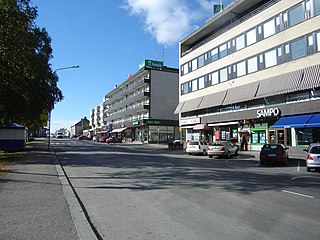
Tornio is a city and municipality in Lapland, Finland. The city forms a cross-border twin city together with Haparanda on the Swedish side. The municipality covers an area of 1,348.83 square kilometres (520.79 sq mi), of which 161.59 km2 (62.39 sq mi) is water. The population density is 17.66 inhabitants per square kilometre (45.7/sq mi), with a total population of 20,989.
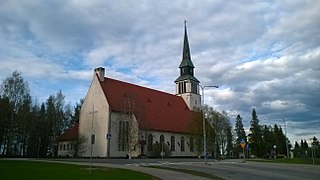
Kemijärvi is a town and municipality of Finland. It is located in the sub-region of Eastern Lapland.

Keminmaa is a municipality of Finland. It is located near the towns of Kemi and Tornio in the Lapland region.

Muonio is a municipality of Finland. The town is located in fell-region of far northern Finland above the Arctic Circle on the country's western border with Sweden, the Muonio River. It lies within the area of the former Lappi (Lapland) province in the Fell Lapland subregion. The next closest Finnish municipalities are Enontekiö to the north, Kittilä on the east, and Kolari to the south. Southwest of the town, a road bridge crosses the Muonio River, across the river, in Sweden, lies the nearby hamlet of Muoniovaara in northern Pajala Municipality in Norrbotten County.

Pelkosenniemi is a municipality of Finland. It is located in the province of Lapland. The municipality has a population of 916 (31 October 2024), which make it the smallest municipality in Lapland in terms of population. It covers an area of 1,881.58 square kilometres (726.48 sq mi) of which 45.4 km2 (17.5 sq mi) is water. The population density is 0.5 inhabitants per square kilometre (1.3/sq mi). Neighbour municipalities are Kemijärvi, Rovaniemi, Salla, Savukoski and Sodankylä.

Kuusamo is a town and municipality in Finland. It is located in Koillismaa, the northeastern part of the Northern Ostrobothnia region. The municipality has a population of 14,783 and covers an area of 5,808.92 square kilometres (2,242.84 sq mi) of which 830.81 km2 (320.78 sq mi) is water. The population density is 2.97 inhabitants per square kilometre (7.7/sq mi).

Sodankylä is a municipality of Finland. It is located in the region of Lapland, and lies at the northern end of Highway 5 (E63) and along Highway 4 (E75). The Kitinen River flows near the center of Sodankylä. Its neighbouring municipalities are Inari, Kemijärvi, Kittilä, Pelkosenniemi, Rovaniemi, and Savukoski. The municipality has two official languages: Finnish and Northern Sami.
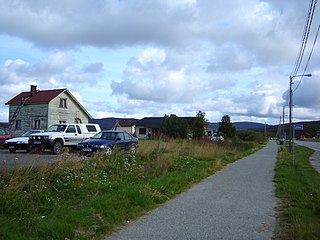
Nuorgam is a village in the Utsjoki municipality in the region of Lapland, Finland. It has approximately 200 inhabitants. It is the northernmost point of Finland and the northernmost point of the European Union. It is situated on the Deatnu river, which is very popular for salmon fishing. Nuorgam is located near the villages of Utsjoki and Tana bru. The nearest cities are Murmansk, Rovaniemi, Hammerfest, Alta and Tromsø.
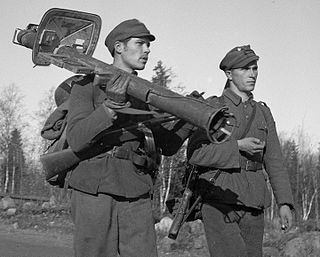
The Battle of Tornio was the first major engagement between Nazi Germany and Finland in the Lapland War; although hostilities had already begun elsewhere.

The Battle of Rovaniemi was an event during the 1944 Lapland War. The actual fighting between the components of the Finnish Armoured Division and Finnish 3rd Division against the troops of the German Twentieth Mountain Army took place at the vicinity of the town of Rovaniemi. The notoriety of the encounter derives from the near-total destruction of the town.

The Bothnian Bay or Bay of Bothnia is the northernmost part of the Gulf of Bothnia, which is in turn the northern part of the Baltic Sea. The land holding the bay is still rising after the weight of ice-age glaciers has been removed, and within 2,000 years the bay will be a large freshwater lake since its link to the south Kvarken is mostly less than 20 metres (66 ft) deep. The bay today is fed by several large rivers, and is relatively unaffected by tides, so has low salinity. It freezes over each year for up to six months. Compared to other parts of the Baltic, it has little plant or animal life.
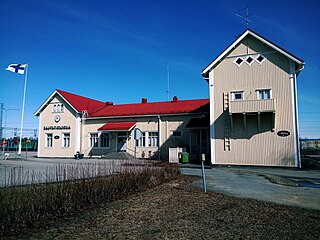
Kemi railway station is located in the town of Kemi in the Lapland Region of Finland. It is operated by VR. The distance to the Helsinki Central railway station, via Haapamäki and Oulu stations is 858.3 kilometres.

Lappmarken was an earlier Swedish name for the northern part of the old Kingdom of Sweden inhabited by the Sami people. In addition to the present-day Swedish Lapland, it also covered Västerbotten, Jämtland and Härjedalen, as well as the Finnish Lapland. As a name, it is related to Finnmark, an old Norwegian name for the Sami area. "Finn" and "Lapp" are mutually exchangeable old names for the Sami people, although the latter is sometimes deemed offensive.

During World War II, the Lapland War saw fighting between Finland and Nazi Germany – effectively from September to November 1944 – in Finland's northernmost region, Lapland. Though the Finns and the Germans had been fighting together against the Soviet Union since 1941 during the Continuation War (1941–1944), peace negotiations between the Finnish government and the Allies of World War II had been conducted intermittently during 1943–1944, but no agreement had been reached. The Moscow Armistice, signed on 19 September 1944, demanded that Finland break diplomatic ties with Germany and expel or disarm any German soldiers remaining in Finland.
Lapland University of Applied Sciences, in short Lapland UAS, is a Finnish polytechnic university located in the cities of Kemi, Tornio and Rovaniemi. It was founded on January 1, 2014 as a merger between Rovaniemi University of Applied Sciences and Kemi-Tornio University of Applied Sciences. The merger carried over all the features of the previous organizations in an expanded organization form.

Kauko Ensio Seppänen was a Finnish sculptor, professor (1978) and sculpture pioneer in Lapland. He created a total of 127 public sculptures. On the occasion of his crafting more public sculptures than any other artist in Finland, the 7 September 1984 issue of Finnish newspaper Helsingin Sanomat bore the headline "Sculptor Ensio Seppänen, is a Finnish record man".

The Arctic Railway is a planned railway line linking the Norwegian Arctic port of Kirkenes with the Finnish railway network.

























